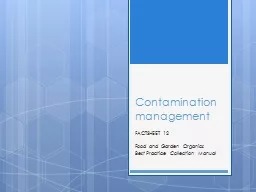

FACTSHEET 12 Food and Garden Organics Best Practice Collection Manual The importance of low contamination Its important to maintain low levels of contamination in order to Decrease processing costs ID: 917889
Download Presentation The PPT/PDF document "Contamination management" is the property of its rightful owner. Permission is granted to download and print the materials on this web site for personal, non-commercial use only, and to display it on your personal computer provided you do not modify the materials and that you retain all copyright notices contained in the materials. By downloading content from our website, you accept the terms of this agreement.
Slide1
Contamination management
FACTSHEET
12
Food and Garden Organics
Best Practice Collection Manual
Slide2The importance of low contamination
It’s
important to maintain low levels of contamination, in order to:
Decrease processing costs
Ensure the products meet regulatory requirements
Ensure the composted products can be marketed and used without causing harmful environmental impacts.
Slide3Contaminants in organics
Contaminants can be differentiated into:
Physical contaminants
, which comprise non-compostable impurities (e.g. plastic, glass, metal, rocks)
Chemical contaminants
, which include mainly heavy metals and herbicides
Biological contaminants
, which represent plant, animal and human pathogens and also viable plant parts or seeds.
Slide4Contamination management
A contamination management prevention plan should be developed and include:
Education
material for householders, including visually appealing lists and stickers of what can and what can’t go into the organics bin. Clear symbols (i.e.
ticks
and crosses) should be used to ensure the material is easily understood.
On-going public education and motivation.
Communications material for the local media, councillors, senior staff etc.
Arrangements with waste collection personnel regarding contaminated bins and use of contamination tags for
non-compliant households.
Arrangements with the processor regarding contaminated material for the initial roll out of the service and on-going maintenance of the service. This may include penalty payments if contamination levels exceed a certain threshold.
Continuous monitoring and evaluation in problem areas through bin inspections, waste auditing and community consultation.
Slide5Issues to be aware of
Particular issues related to combined food and garden organics collections include
:
Liners:
promote
compostable plastic liners, paper liners or no liners.
Liner supply:
i
f
liners are promoted whether they will be supplied by council (how many for how long) or if residents have to provide their own.
Contaminant removal:
whether
plastic bags and other large impurities are going to be handpicked and removed at the processing facility or not. Hand sorting
increases
processing costs and may also require colouring or marking compostable bin liners so they can be easily differentiated from other
plastics.
Use of a bag shredder:
will a shredder
be deployed to rip open compostable bin liners to release food
material?
This may result in small pieces of non-compostable plastic within the end
product.
Organics shredder:
will
kerbside collected garden and food organics be
shredded? This could result
in small pieces of plastic that are hard to separate from the finished compost and mulch.
Communications:
will contaminated
bins
be
identified, remedial action taken with the individual household and the service ultimately removed if contamination
continues?
Community and council support for the service may influence acceptance of various options for dealing with households unable or unwilling to correctly use the service.
Slide6NB:
Information in this presentation is taken from the
Food and Garden Organics Best Practice Collection Manual
(2012) published by the Department of Sustainability, Environment, Water, Population and Communities. The full document is available on the department’s website
www.environment.gov.au/wastepolicy/publications/organics-collection-manual